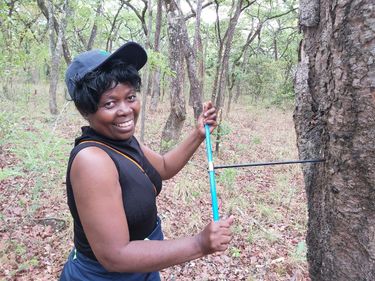
Sessions in which Margot Kuitems participates
Wednesday 29 June, 2022
Dendrochronology is considered one the most precise of all the scientific dating techniques. However, it requires long sequences of tree rings and a master record for both the species and region in question. At the University of Groningen, we have been pioneering a new approach to dating that combines the precision of dendrochronology with the versatility of radiocarbon dating. It relies on the detection of spikes in the annual radiocarbon record, thought to b...
Sessions in which Margot Kuitems attends
Monday 27 June, 2022
Free, in person and onlineThe stable isotopic compositions of carbon and oxygen (d13C and d18O) measured in tree rings are valuable proxies for reconstructing paleoclimate and are increasingly used as paleophysiological proxies. Applying these proxies in ecophysiology and paleoclimate can be challenging as they rely on complex process-based models and poorly constrained input data. In recent years, h...
Tuesday 28 June, 2022
Africa is faced with a number of challenges including climate change and ecological disturbance due to various anthropogenic activities. These problems adversely affect the forests and also ecosystem services. My appreciation for the forests motivated me to pursure my undergraduate studies in Forestry. I first applied dendrochronology during my PhD research which focused on understanding the climate change vulnerability of the Zambezi teak forests in Zambia. However, lack of research facil...
Forest disturbances and tree growth are major drivers of dynamics and long-term carbon storage in forests. Combining forest inventory data and tree-ring analysis allows for a retrospective estimate of aboveground forest biomass (AGB) and disturbance dynamics at decadal to centennial scales, both being directly related to net primary productivity (NPP). We used this combined approach to estimate precisely-dated ages of aboveground carbon in over 20 temperate old-growth forests in Western Eu...
"Emerging in the early 20th century, the scientific study of tree-rings has a rich but under-cultivated history. This project reviews the historiography (or the history of historical writing) of dendrochronology. From the pioneering work of A.E. Douglass and others to the establishment of institutions dedicated to advancing dendrochronology by the 1950s, the field has secured its place as an ensemble of techniques to interpret tree rings, with applications in archeology, climatology, ecolo...
Tree-ring research has given generations of scientists a long memory of what is acceptable for a tree to be included for data analysis. The established criteria, however, were set through purposeful goals to maximize the response for climatic reconstructions. Ecology is different. Tree-rings are increasingly being used to study a wide swath of ecology, including the carbon cycle or the response of ecosystems to global changes. A fundamental aspect of ecology is to understand the range of r...
In the context of climate change, more research is needed to better understand the impact of short-term environmental stressors on forest productivity. Intra-annual data provide crucial information to achieve this objective. Our project aims to determine the responses of tree growth and water status of boreal tree species (jack pine, black spruce and quaking aspen) under variable meteorological conditions and on contrasted soil surficial deposits using intra-annual measurements from dendro...
Intra-annual tree-ring δ13C record has the potential to provide deep insights into past plant performance and environmental conditions. With concomitant high temporal resolution δ13C analysis of non-structural carbohydrates, the processes behind observed low- and high-frequency δ13C changes in tree-ring record could be interpreted more reliably. This is essential for predicting forest response to impacts of climate change, such as more frequent and severe drought episodes.To better ...
Improving our understanding of the carbon cycle is key to addressing the challenges of climate change. In this study, we investigated the relationships between intra and inter-annual climate variations, carbon fluxes, and the xylem biomass in an 80-year plantation of Pinus strobus at Turkey Point, Ontario, Canada. From eddy covariance tower, we obtained daily Gross Primary Production (GPP), precipitation and air temperature for the period 2003-2018. To determine inter-and intra-annual xyle...
Ring-width (RW) and Blue Intensity (BI) parameters (earlywood - EWB, inverted latewood – LWBinv, and delta - DB) were measured from samples of Araucaria araucana from six sites in northern Patagonia, Argentina. The distance between the most southerly and northerly sites is ca. 130 kms. Despite a much weaker between-tree signal for the BI parameters than RW, principal component analysis identifies a much stronger regional between-site signal for the BI parameters. Split period correlation r...
The Laacher See Eruption (LSE) ranks among Europe’s largest Upper Pleistocene volcanic events. Although its tephra deposits represent an important isochron for the synchronization of proxy archives at the Late Glacial to early Holocene transition, uncertainty in the eruption age has prevailed. Combined analysis of high-precision ring width and radiocarbon measurements from individual rings of trees that were killed during volcanic eruptions and buried by their deposits can provide eruption...
"Little is known about the impact of volcanoes on trees from the Southern Hemisphere. In this study, we investigated whether volcanic signals could be identified in ring widths from eight dendrochronological species from New Zealand, using superposed epoch analysis. We found that most species are good recorders of volcanic dimming and that the magnitude and persistence of the post-event response can be broadly linked to plant life history traits - whether the species responds as a 'stress ...
Wednesday 29 June, 2022
Dendrochronology is considered one the most precise of all the scientific dating techniques. However, it requires long sequences of tree rings and a master record for both the species and region in question. At the University of Groningen, we have been pioneering a new approach to dating that combines the precision of dendrochronology with the versatility of radiocarbon dating. It relies on the detection of spikes in the annual radiocarbon record, thought to b...
Over the past 10 years, X-ray Computed Tomography (CT) has been increasingly applied to dendrochronological research. This technique provides 3D images of the internal structure of objects, allowing non-invasive access to tree rings in cultural heritage objects that are often inaccessible from the outside. Here, we will present the state-of-the-art of tomographic X-ray imaging for the application to dendrochronology. We will give a comprehensive overview of how X-ray computed tomography is...
Information garnered from historical timbers and wooden artifacts (e.g. houses, barns, ships) can greatly enhance our understanding of human, ecological, and climate history, especially in regions where few old-growth forests and trees remain, tree longevity is relatively short (less than 300-400 years), and environmental conditions break down wood rather quickly, like in mesic to wet regions. Over the last decade plus, the application of tree-ring techniques on wo...
Humans have relied on wooden timber material for the construction of buildings, trade, ships, artifacts, and works of art for many millennia. Using dendrochronological methods, it is often possible to develop to build internally cross-dated but undated ‘floating’ tree-ring chronologies using this historic wooden material. However, the dynamic nature of human mobility and long-distance transport of timber can often make it difficult to accurately date and provenance wooden material. Accurat...
Dendrochronology is a well-established science used to determine the date of wood from cultural heritage objects, and often, to infer the geographic origin of the wood withing certain regions. Dendrochronologists insists that this science provides a date and provenance for the wood, not the object. However, recent research shows that it may be possible to determine the production place of works of art based on the area supplying the wood, and on inferences about wood derived from individua...
Carbon-14 (14C) is produced via a nuclear reaction between the atmosphere and cosmic rays. Although the main source of 14C is galactic cosmic rays, solar energetic particles (SEPs) also contributes in producing 14C. Extreme SEP events are considered to produce 14C spikes that considerably exceed the 14C amount produced by galactic cosmic rays. Thus far, several signatures of 14C spikes originates by extreme SEP events have been reported, such as the 774 CE, 992 CE, and ~660 BCE events. In ...
Information garnered from historical timbers and wooden artifacts (e.g. houses, barns, ships) can greatly enhance our understanding of human, ecological, and climate history, especially in regions where few old-growth forests and trees remain, tree longevity is relatively short (less than 300-400 years), and environmental conditions break down wood rather quickly, like in mesic to wet regions Over the last decade plus, the application of tree-ring techniques on woo...
In Northwestern Alaska, well-preserved architectural timbers from coastal Neo-Inuit archaeological sites can be used to document the climatic variations and cultural transformations of the beginning of the 2nd millennium AD. In this treeless tundra environment, the main wood resource is driftwood from interior Alaskan forests, carried to the coast by major rivers and ocean currents. Conventional dendrochronology allowed cross-dating 68 architectural timbers out of 282 archaeolo...
Presentation of all Ameridendro2022 posters.FREE LUNCH FOR ALL ATTENDEES!
Rescheduled from June 28th to June 29th
This is a mandatory (!) .... and FREE (!!) cocktail & award ceremony (!!!)(in replacement of the Banquet formula)->->->->->->->->->->->->->->->->->->After a great summer day of scientific and urban discoveries in our beloved MTL, we wish to bring together all the AmeriDendro community in one place and congratulate the TRS awardees for their remarkable achievements! -Bonsinsegna award-Fr...
Thursday 30 June, 2022
How old are tropical trees? This fundamental question has long driven the curiosity of laymen and scientists. But only recently, a great number of studies conducted by many brave dendrochronologists resulted in a significant tree-ring-based knowledge that allows us to start accurately estimating tree ages across the globe. As science goes, not only knowing the longevity of tropical trees is essential to understanding forest dynamics and its role in biogeochemical cycles, but one must also ...
Dendrochronological archives in the tropics of the Americas have been under-studied for a long time. Some of the challenges include the Identification of tree-ring boundaries in certain tree species, absence of winter dormancy associated to low temperatures in most of the cases, and logistic difficulties of fieldwork in remote sites. However, part of the slow progress is also related to the fact that historically much less resources have been inv...
Methodological advances in the latest years have opened new perspectives for dendrochonological studies by facilitating the visualization, delimitation, and analyses of tree-rings. These novel methodologies have incorporated complementary physical and chemical parameters to the traditional anatomical procedures used to describe annual growth rings. Here, we present the results of new studies which explore the relationships among wood density features and chemical elements involved in the a...
Exploring new study sites and potential species is still a fundamental step in tropical dendrochronology. The results of exploratory field campaigns usually reflect the intrinsic biodiversity of the tropics: a plethora of wood anatomy variation and seemly true tree-ring boundaries. Often, some species are excluded during the process of selecting the best species due to indistinct or rather unclear tree-ring delimitation, aside from the difficult task to discriminate the commonly found fals...
Tropical regions are generally characterized by dynamic ecosystems where the abundant availability of energy and resources allows for an almost constant growth of its flora, being xeric forests and flood plains some exceptions. Classical dendrochronology studies have been scarce in these areas as many tree species does not show well defined tree-ring boundaries. We present different study cases on how quantitative wood analysis and radiocarbon can complement classical dendrochronology incr...
In tropical environments of central America, tree-ring forming species are rare to find, especially in areas with pronounced aseasonality, but wood anatomical traits can equally provide important information on species life-histories and response to disturbances. Dating wood anatomical structures remains a crucial task to decipher the ecological information recorded in xylem cellular parameters in absence of defined ring boundaries, particularly to observe the footprint of discrete disturb...
In their book chapter in 2011 Gagen et al. (2011) highlighted the need for stable isotope dendroclimatology to move beyond studies that simply demonstrate ‘potential’. This symposium, more than a decade since this publication, will focus on dendrogeochemical studies that demonstrate that the field has moved beyond studies focused on ‘potential’. In particular, this session will strive to identify compelling new insights into unique aspect...
The use of multiple data from tree-rings, including isotopic ratios and xylogenesis monitoring, can enhance our interpretations on tree functioning and on tree-environment relations. Here, we explored whether understanding of carbon deposition to tree-rings could be improved using: (1) monitoring of wood cell formation during the growing season, (2) intra-annual data of d13C in tree-ring cellulose and (3) ecophysiological modelling. We collected wood micro-cores to monitor wood cell format...
Solar Energetic Particle (SEP) events cause an increase in atmospheric radiocarbon (14C) concentration.14C spikes in 774-775 and 993-994 CE have been measured in numerous tree-ring chronologies worldwide. Two other 14C excursions, in 1052 and 1279 CE, have been reported from Northern Hemisphere tree-ring chronologies. A critical factor for SEP event detection is the resolution of the tree-ring samples. Annually resolved records required to detect these short-term excursions can be costly, ...
A gap of millennial tree-ring data suitable for dendroclimatology has long been evident in the North American boreal forest. In my talk, I will describe the adaptive approach we have developed to build and improve a data network for millennial dendroclimatology in the eastern Canadian taiga. Recurrence of stand replacing wildfires is the most important constrain to the elaboration of long tree ring chronologies, which can only be developed away from regions ...
Climate change across the western US has increased air temperature, resulting in decreased snow and lengthening of the summer drought. Recent studies have also highlighted the positive feedback loops between soil moisture and vapor pressure deficit (VPD), which can exacerbates aridity in water limited ecosystems. These interactions can make it difficult to untangle the influences of soil moisture and VPD on tree growth, and yet our ability to untangle these parameters is important for buil...
The interpretation of stable isotopes in a dendroecological framework can provide powerful insights into how trees adjust physiologically in response to the environment. This symposium aims to bring together researchers who use stable isotopes in tree rings to address ecophysiological responses to environmental changes from intra-annual to multi-decadal resolution. We hope this symposium will enable fruitful discussions and new ideas a...
Hydrogen isotope ratios in tree ring cellulose (δ2HC) have been recognized as a potential proxy for plant-climate interactions, plant physiology, and carbon metabolism. This goes along with recent studies showing species-specific δ2HC differences that cannot be explained by climatic conditions. However, systematic investigations on the phylogenetic impact on 2H-fractionations in carbohydrates of woody plant species are missing.Here, we sampled leaves and twigs of 152 trees and ...
Under elevated CO2, photosynthetic carbon isotope discrimination is expected to increase in response to photosynthesis stimulation. While this response is widely documented in laboratory and field experiments, long-term proxies indicate that such response is not universally observed in response to the growth of atmospheric CO2. We investigated historical trends of photosynthetic carbon isotope discrimination derived from carbon isotope measurements of tree rings (Δ13C) from 147 chron...
(by bus, max 92 people)Designed for visitors and newcomers, the tour is based on the pleasure...




